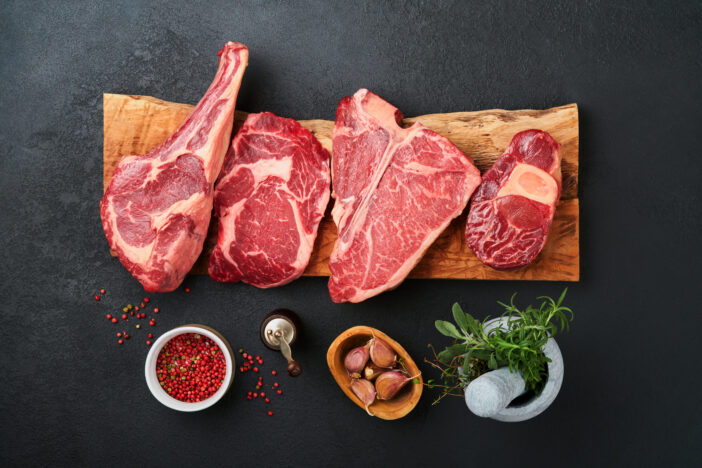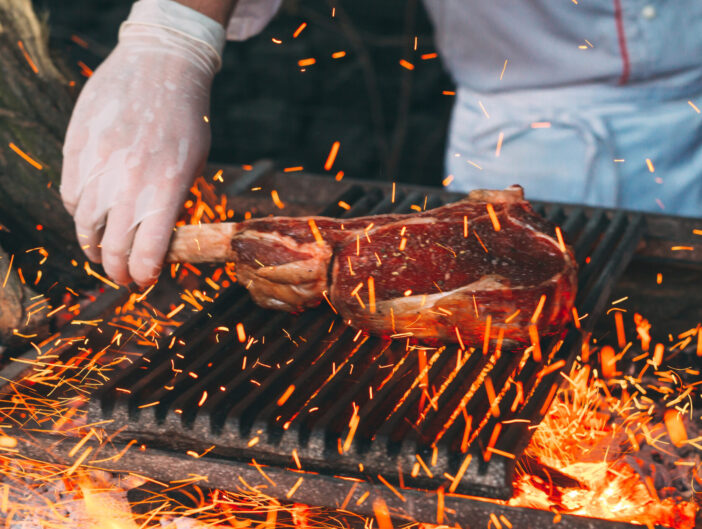10 Gourmet Steak Grilling Tips to Elevate Your BBQ Game
Elevate your grilling game with gourmet steaks by choosing the right cut, using essential tools, mastering grilling times, and applying advanced techniques for flavorful, juicy results.

Imagine elevating your grilling game to master chef levels where every steak is a masterpiece. This guide will unlock the secrets of gourmet steak grilling, transforming your backyard barbecues into a culinary event.
Disclosure: As an Amazon Associate, this site earns from qualifying purchases. Thank you!
Choosing the Right Cut of Steak

To elevate your steak grilling, selecting the right cut is crucial. Each type offers a different balance of flavor, texture, and fat, making some cuts more suited for certain preparations than others.
Ribeye: A Flavorful Favorite
Choose Ribeye for its marbling and fat content, which enriches its flavor. This cut comes from the rib section and boasts a juicy, beefy flavor unmatched by leaner cuts. It’s perfect for grilling over high heat, allowing the fat to render and the steak to develop a delicious crust.
Filet Mignon: Tender and Rich
Opt for Filet Mignon when tenderness is your top priority. Known for its buttery texture, this steak cut from the smaller end of the tenderloin is low in fat but rich in taste. It cooks quickly and is best served medium-rare, paired with bold sauces like béarnaise to enhance its subtle flavor.
T-Bone: Best of Both Worlds
Select a T-Bone to enjoy two types of steak in one: tender filet and flavorful New York Strip. This cut is ideal for those who appreciate both textures. Grill it to medium rare and let it rest before serving to ensure each bite is as flavorful as possible.
Essential Grilling Tools for Steak

To grill the perfect steak, it’s crucial to have the right tools. Here’s what you’ll need:
High-Quality Grill
Choose a grill that offers even heat distribution and precise temperature control. Gas grills are great for their ease of use and quick heat-up time, while charcoal grills provide that coveted smoky flavor. For gourmet results, consider a high-end model with durable construction and enhanced features, like built-in thermometers and adjustable grill heights.
Meat Thermometer
Don’t guess — use a digital meat thermometer to ensure your steak reaches the perfect level of doneness. For a medium-rare finish, aim for an internal temperature of 130-135°F. A good thermometer can provide quick and accurate readings, helping prevent overcooking.
Tongs and Spatulas
Invest in a pair of long-handled tongs and a sturdy spatula to handle your steaks safely and efficiently. Look for tongs that provide a good grip and can easily flip your thick cuts without piercing them. A spatula with a wide base is ideal for larger steaks, ensuring you can move them with ease and without damaging the meat.
Prepping Your Steak for the Grill
Now that you’ve selected your ideal cuts and gathered your grilling tools, let’s focus on preparing your steak perfectly for the grill.
Seasoning: Keeping It Simple
Season your steak with a light touch – simplicity is key. Use freshly ground salt and black pepper to enhance the natural flavors of the meat. Here’s how:
- Apply a generous pinch of salt to each side of your steak.
- Add freshly ground black pepper to taste.
- Avoid over-seasoning to let the steak’s true flavor shine through.
A simple seasoning approach allows the quality of the meat to stand out, particularly with high-grade cuts like Ribeye, Filet Mignon, and T-Bone.
To Marinate or Not to Marinate
Deciding whether to marinate your steak depends on both the cut and your flavor preferences.
- Tougher cuts like skirt or flank steak benefit from marination as the acids can help tenderize the meat.
- Premium cuts like Filet Mignon are best enjoyed with minimal seasoning, as marinating can overpower their natural tastes.
If you opt to marinate:
- Keep the marinating time under six hours to prevent the meat from becoming mushy.
- Choose a marinade that complements the steak’s rich flavors, like a blend of olive oil, herbs, and garlic.
Bringing Steaks to Room Temperature
Allow your steaks to reach room temperature before grilling. This step is crucial for even cooking:
- Take the steaks out of the refrigerator for about 30 minutes before grilling.
- Letting them sit helps relax the muscle fibers, enhancing tenderness and flavor.
Remember, room-temperature steaks cook more evenly, achieving that perfect doneness you’re aiming for in a gourmet grilled steak.
Mastering Steak Grilling Times and Temperatures
Achieving the perfect steak on the grill requires precise timing and temperature control. Here’s how to grill steak to various levels of doneness for optimal results:
Rare, Medium, and Well-Done
- Rare: Cook to an internal temperature of 120-125°F for a soft texture and red center. Grill approximately 2-3 minutes per side on high heat, ideal for cuts like flank or skirt steak.
- Medium: Aim for 135-145°F with a firmer texture and pink center. Grill about 4-5 minutes per side, suitable for cuts like ribeye or T-bone.
- Well-Done: Cook to 160°F or higher for a firm, grayish interior. Grill approximately 6-7 minutes per side, best for thicker cuts such as sirloin or porterhouse.
Tips for Precision
- Insert Correctly: Place the thermometer into the thickest part of the steak, avoiding fat or bone, for accurate temperature readings.
- Digital vs. Analog: Digital thermometers provide quick and precise readings, while well-calibrated analog models can also be effective.
- Check Regularly: Monitor the temperature frequently as you approach the desired doneness to prevent overcooking.
Mastering these grilling techniques ensures your steak is cooked just the way you prefer, whether rare, medium, or well done.
Advanced Grilling Techniques

Now that you’ve mastered the basics, it’s time to elevate your gourmet steak grilling with some advanced techniques that ensure your steaks stand out at any barbecue.
Creating Perfect Grill Marks
Achieve those sought-after, picture-perfect grill marks by heating your grill too high before placing your steaks on it. Position your steak at a 45-degree angle and let it sear undisturbed for about 2 to 3 minutes. Rotate it 90 degrees (without flipping) and grill for another 2 to 3 minutes. This method creates a crosshatch pattern, enhancing not only the look but also the surface texture of your steak. Always preheat your grill for at least 10 minutes to get the best results.
Using the Reverse Sear Method
The reverse sear method is ideal for thick cuts like a Ribeye or Filet Mignon. Start by slowly cooking your steak on a cooler part of the grill with indirect heat until it’s about 10-15°F below your desired doneness. Then, move it over to a high-heat area to sear the outside quickly, creating a crispy, golden-brown crust. This technique allows for greater control over the cooking temperature, ensuring a perfectly cooked, juicy steak. Make sure to let the steak rest for about 5 minutes before serving it.
Smoking Steaks for Added Flavor
Smoking adds a rich, smoky flavor to your steaks that can’t be achieved with regular grilling. Use wood chips like hickory or mesquite to enhance the flavor profile. Pre-soak the chips in water for about an hour, then place them in a smoker box or directly on the charcoal before adding your steak. Grill over low, indirect heat to infuse the steak with smoky flavors. The key is maintaining a consistent, low temperature (about 225°F) to maximize smoke absorption without overcooking the steak.
Post-Grilling Tips

After grilling your gourmet steaks to perfection, follow these essential steps to enhance their flavor and juiciness:
Resting Your Steaks
- Allow Time to Rest: Let steaks rest for 5 to 10 minutes post-grill to redistribute juices evenly.
- Cover Lightly: Tent steaks with aluminum foil to keep them warm without overcooking.
- Use a Warm Plate: Serve steaks on a warm plate to maintain optimal temperature and enhance dining pleasure.
Slicing Technique
- Identify the Grain: Note the direction of muscle fibers (‘grain’) in the steak for optimal slicing.
- Slice Perpendicular: Cut across the grain to break up muscle fibers, ensuring each piece is tender.
- Use the Right Knife: Use a sharp chef’s or carving knife for clean cuts that preserve the steak’s shape and juices.
By following these steps, you’ll ensure your grilled steaks are not only perfectly cooked but also presented and served to maximize their flavor and texture.
Frequently Asked Questions
What are the best cuts of steak for grilling?
For grilling, the best steak cuts are Ribeye, Filet Mignon, and T-Bone. These types offer a favorable balance of flavor and texture, making them ideal for achieving gourmet-quality results.
What are the essential tools needed for grilling steak?
Essential tools for grilling steak include a reliable grill, long-handled tongs, a high-quality meat thermometer, and a basting brush. These tools help in managing the grilling process and achieving the desired doneness more precisely.
How should steaks be prepared before grilling?
Steaks should be allowed to come to room temperature before grilling. Season them according to taste with salt, pepper, and other preferred spices or marinades for enhanced flavor.
What are the recommended grilling times and temperatures for different levels of steak doneness?
- Rare: About 2-3 minutes per side at high heat, internal temperature should be around 125°F.
- Medium Rare: Approximately 3-4 minutes per side, aiming for an internal temperature of 135°F.
- Medium: Grill for about 5-7 minutes per side, with an internal temperature of 145°F.
- Well-Done: Cook for about 8-10 minutes per side, reaching an internal temperature of 160°F.
How do you use a meat thermometer effectively when grilling steak?
Insert the meat thermometer into the thickest part of the steak, avoiding fat and bone. Check the temperature a few minutes before the expected finish time to avoid overcooking, especially for thinner cuts.
What is the reverse sear method, and when should it be used?
The reverse sear method involves initially cooking the steak on a lower indirect heat before finishing it on high direct heat. This technique is ideal for thicker cuts like Ribeye or Filet Mignon to achieve a uniformly cooked interior with a beautifully seared crust.
How can smoking enhance the flavor of grilled steaks?
Smoking steaks by using wood chips on the grill lends a rich, smoky flavor that enhances the natural taste of the meat. For best results, maintain a lower, consistent temperature and allow the steaks to absorb the smoky aroma gradually.
What should be done with steaks after grilling to enhance their juiciness and flavor?
After grilling, allow steaks to rest for about five minutes, covered loosely with aluminum foil. This step helps the juices to redistribute throughout the meat, enhancing flavor and tenderness. Serve on a warm plate and cut perpendicular to the grain for the best texture.






